
King Charles I stands centre wearing the blue sash of the Order of the Garter; Prince Rupert of the Rhine is sat next to him and Lord Lindsey stands next to the king resting his commander’s baton against the map. The Prince of Wales (later Charles II) and the Duke of York (later James II) are the two boys behind Prince Rupert’s back. The standard-bearer is Sir Edmund Verney.
By Tyler Rossi for CoinWeek …..
A defining event for Great Britain in the mid-17th century, the English Civil War fragmented British society causing great unrest, the first legally sanctioned regicide, and the deaths of almost 200,000 people. At an estimated 4.5% of the population, this astronomical British death toll was unmatched until almost four hundred years later during World War I (1914-1918). In basic language, the conflict was fought over religion and “discontent over the king’s [Charles I] use of power and his economic policies”. The king’s supporters, called Royalists or Cavaliers, had strong bases of support in the northern and western areas of Great Britain, while the Parliamentarians, called “Roundheads” due to their distinctive haircuts, were based in the island’s eastern and southern regions.
As the war progressed and the Royalist cause lost ground, many of their castles were besieged, “resulting in severe damage”. These sieges were long-drawn-out affairs that cut off the castles from the outside world and ultimately forced the besieged Royalists to produce their own money. Called “siege money”, these coins were produced to pay soldiers and maintain internal commerce.
To produce this coinage, officials “requisitioned silver objects” (silver plate, cups, silverware, etc.) that were then repurposed into standardized monetary units. This process varied in thoroughness. Sometimes the silver items were melted, before being either cast into round planchets or chopped into angular blanks prior to the striking process. However, if the castle did not possess the proper smelting tools, the authorities would simply chop up the confiscated silver into pieces. The original patterns of the host silver can sometimes be seen under the coin’s design.
Of these siege coins, the most famous were those produced during the sieges of Newark, Carlisle, Pontefract, and Scarborough.
Newark
Between 1643 and 1646, the Royalist city of Newark “suffered” three Parliamentarian sieges until finally surrendering on May 8, 1646. Initially, the castle was “seized” in late 1642 by the High Sheriff of Nottinghamshire, Sir John Digby, and his Royalist forces. The aborted first siege of 1643 was called off after only one day when the Parliamentarian Major-General Thomas Ballard correctly realized he did not have sufficient forces to take the city.
After fighting in the surrounding Midlands intensified, Parliament managed to force the Newark garrison to send troops to assist the embattled Marquis of Newcastle. While the Royalist troops were out fighting, Sir John Meldrum led a force of 6-7,000 Roundheads to lay siege once again to Newark. Lifted briefly by a relief force led by Prince Rupert, this second siege ended in a Royalist victory, with Meldrum’s forces surrendering their guns and leaving Newark.
After Scotland defected to the Parliamentarians, a force of 16,000 men marched south to initiate the third and final siege. Arriving on November 26, 1645, these troops dug in deep. Since Royalist power in the region was effectively broken, no troops could be brought in to relieve the siege. The city limped along until Charles I was forced to surrender the city as part of his general surrender on May 8, 1646.
It was during this final siege that the famous Newark diamond siege coins were struck. Due to their emergency nature, these coins were struck only in half-crown, shilling, ninepence, and sixpence denominations. The denominations are marked on these coins with the following symbols: XXX, XII, IX, and VI for the Half-crowns, shillings, ninepence, and sixpence respectively.
On the obverse, these interesting coins depict the royal cipher (a crown between “C” and “R”) above the denomination. On the reverse, the city name stands in bold over the year 1646. Above is the abbreviation “OBS”, which stands for the Latin word obsidium, meaning “siege”.
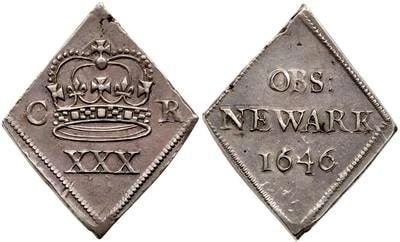
Simple yet powerful imagery evoking the severity of Newark’s last siege. According to the accounts of survivors, “food was so scarce that they had to eat horses and dogs”. These coins represented such a powerful message that many, such as the example below, were holed and worn as Royalist badges to show support for Charles I and his son Charles II.
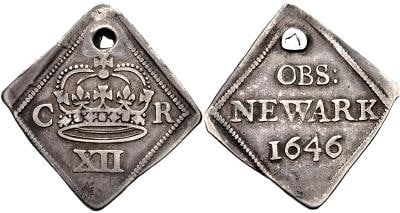
Carlisle
Considered “obsolete” by the early 17th century, Carlisle castle nevertheless settled into a siege in July 1644. One of the only northern Royalist holdouts after the King’s disastrous defeat at the Battle of Marston Moor, Parliamentarian forces “swiftly surrounded Carlisle with guns and earthworks and settled down to starve the city out.” While additional English forces arrived in the spring of 1645, the city’s food stores could not handle the new influx of hungry mouths. As in Newark, “food began to run out,” and the situation soon became desperate. Since the city was so far behind enemy lines there was no “hope of relief.” After slightly less than one year, the city surrendered.
During the siege, it is estimated that 1,162 ounces of silver plate were requisitioned and turned into 1,000 three-shilling coins and 3,460 shillings. Immediately after the siege ended, however, the Parliamentarian forces seized as many coins as they could and to be remelted. As such, they are extremely rare with very few examples surviving today.

Pontefract
A historic seat of royal authority since 1070, Pontefract Castle was held by the Cavaliers in 1642 when fighting broke out. Spared violence until Christmas Day 1644, the castle suffered a bombardment of 1,367 cannon shots. This assault did not cause significant damage, with only one small tower collapsing. After many attempts to breach Pontefract’s walls, the attackers suffered in defeat and retreated when Sir Marmaduke Langdale won the Battle of Chequerfield.
The Parliamentarians “renewed the siege” on March 11, 1645, eventually forcing the castle’s surrender by effectively cutting its lines and preventing food from entering the castle.
Changing hands yet again, Royalist forces recaptured Pontefract in 1648 and held out until the 24th of March, 1649, after Charles I had been captured and executed. It was during this last siege that the Royalists struck a series of emergency coins. The first type was struck before the king’s death and the obverse depicts the royal cypher surrounded by the legend DVM SPIRO SPERO, which translates to “While I Live, I Hope”. The reverse has an image of Pontefract Castle and, like the other examples of siege money, the abbreviation OBS. This die pair can also be found on diamond “lozenge-shaped” blanks.
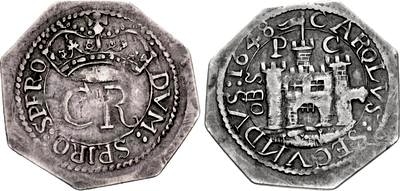
Type II, struck for Charles II after his father the king was executed, is now known as the posthumous series. Extremely rare, this type “proclaimed” Charles II. When combined with the defender’s vigorous opposition, this proclamation motivated Parliament to destroy, or slight, the castle.
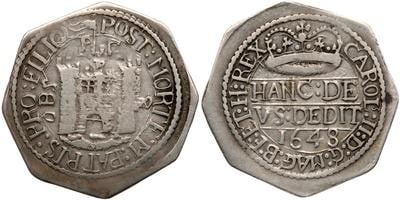
Scarborough
After changing hands several times in the early phases of the English Civil War, the Royalists regained control of Scarborough Castle. Due to its position on the coast, Scarborough severely impacted London’s coal supply and proved to be a thorn in the side of Parliament’s regional control. Finally losing patience, Parliamentarian forces repeatedly attacked the castle. During a particularly “intense” bombardment, “the great tower sheared [off] and half the building collapsed.” Shortly after, on the 25th of July 1645, the castle finally surrendered.
The siege money produced at Scarborough is perhaps the crudest of the war. One of the only authentic pieces dated to the war can be seen below. Most of the examples available on the market are either “fantasy” pieces or 18th-century imitations. Like this authentic example, they are all uniface and depict a stylized image of Scarborough castle as several vertical towers on the face above the denomination.
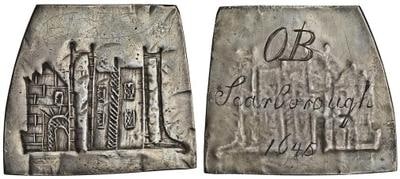
All types of siege money produced during the English Civil War are ladened with symbolism and serve as visual reminders of the suffering and intense hardship suffered by the besieged royalist forces as the war wound down in 1648.
Happy collecting!
* * *
Sources
https://www.english-heritage.org.uk/learn/histories/the-english-civil-wars-history-and-stories/
https://blog.cpmcoins.com/2019/06/03/the-coins-from-the-cutlery-drawer/
https://www.royalmint.com/stories/collect/explore-coinage-during-conflict/
https://www.historylearningsite.co.uk/stuart-england/the-sieges-of-newark/
https://www.english-heritage.org.uk/visit/places/carlisle-castle/history/
https://www.yorkshire.com/inspiration/heritage/yorkshire-battlefields/english-civil-war-in-yorkshire
https://www.spink.com/media/view?id=26
https://www.britnumsoc.org/publications/Digital%20BNJ/pdfs/1905_BNJ_2_11.pdf
https://www.cam.ac.uk/research/news/pop-up-mints-and-coins-made-from-prayers
https://www.english-heritage.org.uk/visit/places/scarborough-castle/history/
* * *
About the Author
Tyler Rossi is currently a graduate student at Brandeis University’s Heller School of Social Policy and Management and studies Sustainable International Development and Conflict Resolution. Before graduating from American University in Washington D.C., he worked for Save the Children creating and running international development projects. Recently, Tyler returned to the US from living abroad in the Republic of North Macedonia, where he served as a Peace Corps volunteer for three years. Tyler is an avid numismatist and for over a decade has cultivated a deep interest in pre-modern and ancient coinage from around the world. He is a member of the American Numismatic Association (ANA).




